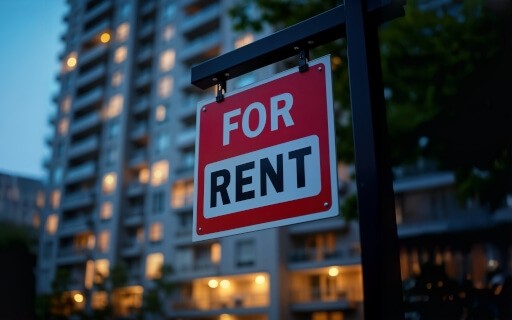
Download our free Lease Violation Letter Template and our Late Rent Notice Template
Key Takeaways
- An eviction is a legal process, and landlords cannot forcibly remove a tenant without due process.
- State laws dictate how long it takes to evict a tenant, but most evictions take one to three months to finalize.
- Apartments.com can help landlords avoid evictions with thorough tenant screening and airtight lease agreements.
Sometimes, eviction is unavoidable. Unforeseen circumstances occur, situations change, and your tenant may stop upholding their part of the lease contract. When this happens, evicting your tenant may be your best option.
Although the process for evictions can seem complicated, knowing the causes, consequences, and actions landlords should take from start to finish can empower you to take action when your tenants consistently violate the lease agreement.
Table of Contents
- What Is an Eviction?
- 10 Steps for Evicting a Tenant
- When Can You Stop an Eviction?
- What NOT To Do
- Create an Airtight Lease with Apartments.com
What Is an Eviction?
Eviction is the forced removal of a tenant from a property. Landlords have the legal right to evict a tenant for continuous lease violations, nonpayment of rent, illegal activities, or property damage.
How long it takes to evict a tenant can vary by state, but most evictions take one to three months to finalize. There are 10 steps to the eviction process, from start to finish:
- The tenant violates the lease
- The landlord sends a preliminary notice
- The landlord sends a quit notice
- The landlord files an eviction petition with the local court system
- The court serves the tenant with the eviction petition papers and the eviction hearing summons
- The landlord and tenant appear in court for the eviction hearing
- The court issues a writ of possession
- The tenant moves out and the landlord turns over the property
- Landlords screen new potential tenants
- Landlords sign a lease with the new tenant
10 Steps for Evicting a Tenant
To avoid legal repercussions, take the following ten steps to file your eviction legally, await the court’s fair ruling, and successfully remove your tenant from the property.
Step One: The Tenant Violates the Lease
To properly evict a tenant, you must present a valid reason for eviction to the court. Typically, landlords point to a specific clause of the lease agreement that a tenant violated.
From failing to pay rent to living with an unauthorized pet, lease violations can come in many forms. Regardless of the scenario, landlords have grounds for eviction when a tenant violates a clause of the signed agreement.
Step Two: Landlord Sends a Preliminary Notice
Preliminary lease violation letters are formal, written warnings for tenants to stop lease-violating behavior. In the warning letter, landlords should include the exact clause the tenant violated and the deadline to correct the violation before facing eviction.
A lease violation notice should look something like the following:
[Property Address, Unit Number]
[City, State, Zip]
[Today’s Date]
Dear [Renter’s First Name],
This letter is to inform you that you are in direct violation of your lease agreement for the following reason(s):
- [Lease Violation]
Please cease this behavior immediately. If this violation is not corrected by [Deadline Date], your lease agreement will be subject to termination.
Should you have any further questions regarding the contents of this letter, please do not hesitate to reach out.
Sincerely,
[Your Signature]
[Your Full Name]
[Your Phone Number or Email]
Landlords send lease violation letters for things like unauthorized occupants, unauthorized pets, or noise or smoke policy violations. To ensure the tenant corrects the behavior, landlords may arrange a property inspection to check the premises for evidence of continued lease violations after the deadline.
In cases of unpaid rent, landlords may send a late rent notice in the preliminary warning letter. A late rent notice should instruct tenants to pay the rent amount due and the late fee amount to rectify the lease violation.
Landlords can follow the following late rent notice template:
[Property Address, Unit Number]
[City, State, Zip]
[Today’s Date]
Dear [Renter Name],
Please note that your rent is past due, and late fees have been applied. Your new total amount due is as follows:
Total late fees due: [Amount]
Total rent due: [Amount]
Please submit your payment within [Number of Days] days of this notice, or you may be subject to lease termination and legal action.
Sincerely,
[Your Signature]
[Your Full Name]
[Your Phone Number or Email]
Regardless of the type of lease violation, landlords may terminate the lease early if a tenant fails to rectify the behavior.
Step Three: Send a Quit Notice
Immediately after the preliminary notice’s deadline, landlords can officially notify tenants to cease the behavior with a quit notice. There are three types of quit notices: pay or quit notices, cure or quit notices, and unconditional quit notices.
Pay or quit notice
Landlords send a pay or quit notice when a tenant has not paid rent. This letter should list the total due in rent, the total due in late fees, and the deadline to pay the outstanding balance or move out before the landlord continues with filing an eviction lawsuit.
Tenants usually have three to five days to pay or quit from the time the notice is issued, but the deadline can vary by state. If a landlord accepts full or partial payment after issuing a pay or quit notice, the eviction process stops, and the landlord will have to start over to remove a tenant from the property.
In some jurisdictions, landlords have the right to reject payments made in full after issuing a notice to pay or quit. Unless the lease or specific local laws say otherwise, landlords are not legally obligated to accept a tenant’s partial payments made after sending a notice to pay or quit.
Cure or quit notice
Landlords can send a cure or quit notice if a tenant violates lease terms unrelated to nonpayment of rent, like the pet policy. This notice warns tenants to fix the lease violating activity or face eviction. Tenants usually have 30 days to fix the issue before eviction proceedings begin, but the exact timeline can vary by state.
Unconditional quit notice
In some cases, a landlord can send an unconditional quit notice requiring tenants to move out immediately. This notice informs tenants of their required move-out date and does not give the opportunity to solve the issue.
Because of the sudden nature of an unconditional quit notice, these notices are reserved for extreme cases like repeated violations, severe damage to the rental, or illegal activity on the property. If the tenant does not willingly move out of the property within the notice’s deadline, landlords can move forward with eviction.
Since all courts require landlords to give tenants a warning before filing for eviction, a quit notice serves as a landlord’s first legal step in the eviction process. Therefore, it is essential to provide a written quit notice. Once the deadline listed in the quit notice passes without resolution, landlords can officially file for eviction and submit the quit notice to the court as supporting evidence.
Requirements for posting quit notices vary by state, so research your local laws to determine how to notify your tenant.
Step Four: File an Eviction Petition
If a tenant’s lease violation continues past the quit notice’s deadline, landlords can file an eviction petition with the local magistrate court. An eviction petition includes the reason for eviction and any evidence, like a copy of the lease signed by the tenant, a record of all payments, and records of previous notices.
Step Five: Serve the Tenant
Once an eviction petition is submitted and approved, local courts will serve the tenant a copy of the landlord’s complaint and a court summons that states the tenant’s obligation to file a response.
Courts can serve the tenant in one of three ways:
- Personal service: The court hand-delivers summons to the tenant.
- Substituted service: The court hand-delivers summons to another legal adult living with the tenant being served.
- Posting: The court delivers summons via certified mail to ensure receipt.
It is illegal for the landlord to serve the eviction hearing papers themselves. The server is typically a court official or a professional process server. The exact requirements for serving a tenant may vary by state, so it’s critical to research your local laws to ensure the legality of your eviction proceeding.
Once the tenant is served, they have a set number of days to respond to the court. If they do not respond, the court may rule in default favor of the landlord.
Step Six: Attend the Eviction Hearing

Once the tenant responds to the court summons, an eviction hearing will be scheduled. Both the landlord and the tenant attend the hearing to present their cases with evidence to the judge. After both parties present their cases, the judge will decide whether the tenant should be evicted from the property.
If the landlord fails to attend the hearing, the courts dismiss the eviction case. If the tenant fails to attend the hearing, the courts rule by default in favor of the landlord. If the judge rules in the tenant’s favor, the landlord can appeal the decision by filing a notice of appeal. The amount of time the landlord has to file a notice of appeal varies by state.
Step Seven: The Court Issues a Writ of Possession
If the judge rules in the landlord’s favor, the court will issue a writ of possession, a court order that authorizes the removal of the tenant from the property.
However, the tenant can delay or prevent their eviction after a writ of possession is issued by doing one of the following:
- Filing a motion to “stay” (delay) the eviction for up to 10 days, giving them more time to move out of the property
- Filing a motion to “set aside” (cancel) the eviction if they believe the eviction was unlawful or unnecessary due to factors like newly discovered evidence or misconduct on the landlord’s part
- Appealing the eviction if they believe the court made a mistake in granting the eviction
If a tenant never files a motion or a notice to appeal, the landlord can initiate the move-out and turnover process.
Step Eight: Turn Over the Property
The amount of time a tenant is allowed to move out after the court issues a writ of possession varies by state, but the tenant will be notified of the deadline. If the tenant does not vacate the property by the deadline, local law enforcement may physically remove the tenant from the property.
Once the tenant vacates the property, the landlord can start turning over the property. First, inspect the rental for damage beyond normal wear and tear like large holes in the walls, broken appliances or fixtures, and unapproved renovations. Calculate the cost of repairing damage caused by the evicted tenant and deduct the cost from the tenant’s security deposit.
In addition to repairing damage, landlords should conduct repairs and maintenance like paint touch-ups, pest control, replacing the HVAC filters, testing the smoke alarms, and checking for plumbing issues. While landlords can use a tenant’s security deposit to cover repairs that are necessary due to damage caused by the tenant, landlords cannot use a tenant’s security deposit for routine maintenance and repairs necessary due to normal wear and tear. These are rental property expenses that landlords should build into a budget.
Once the property is as good as new, advertise the rental on Apartments.com with high-quality photos and a property description that highlights special features.
Tenant turnover can be pricey. The cost of repairs, maintenance, and advertisement can add up, but it’s all worth it to lease to a great tenant after a stressful eviction.
Step Nine: Screen the Next Tenant Thoroughly
One of the best ways to avoid a future eviction is to screen tenants thoroughly. Thorough tenant screening can help landlords weed out risky applicants by identifying red flags like a low credit score and a history of evictions.
Apatments.com makes it easy to screen tenants and get the information you need to find a qualified renter fast. We partner with TransUnion to provide you with reports on an applicant’s rental, credit, and criminal history. If you need more information to make a decision, you can request supporting documents from applicants directly on our platform.
Step Ten: Sign a Lease with the New Tenant

Once a landlord has screened applicants and selected a qualified tenant, landlords will sign a lease with the new tenant and prepare for move-in.
A thorough lease agreement can help landlords avoid disputes with tenants by outlining your rules and expectations regarding rent payments, damage, cleanliness, pets, and more. Landlords cannot legally enforce a rule that is not included in the lease, so creating a thorough lease is crucial.
When Can You Stop an Eviction?
Between legal fees and tenant turnover, evictions are expensive. If your tenant pays everything they owe or agrees to fix lease violating activities, canceling the eviction may save you more hassle.
You can easily stop the process if you haven’t filed an eviction petition since nothing has been officially documented. After you file the eviction, however, your ability to stop the process becomes a little more limited; you’ll have to request a dismissal from the court.
What NOT To Do
Landlords cannot forcibly remove a tenant before or during a court’s decision. This is known as a self-help eviction and is illegal in almost every state.
Self-help evictions include changing the rental’s locks, shutting off utilities, prematurely removing the tenant’s belongings from the property, or threatening or intimidating the tenant in any way. Landlords can face lawsuits if they evict a tenant without due process.
An eviction is a legal process, so landlords must wait for the court’s decision before removing a tenant from the property.
Create an Airtight Lease with Apartments.com
Having a strong lease agreement is key to effectively removing a tenant from your property. Apartments.com makes it easy to create a lease that covers all your bases and complies with federal and state laws. Apartments.com keeps all your leases neatly organized and accessible so you can reference them whenever you like.
When you list your property with Apartments.com, you gain access to the Rental Manager suite where you can prevent evictions with thorough tenant screening reports, legally-binding lease agreements, and an online rent collection platform that makes it easy for your tenants to pay rent each month.
Evictions are necessary sometimes, but Apartments.com’s tools can help you avoid them altogether.
This article was originally published on July 27, 2022, by Chanahra Fletcher.











